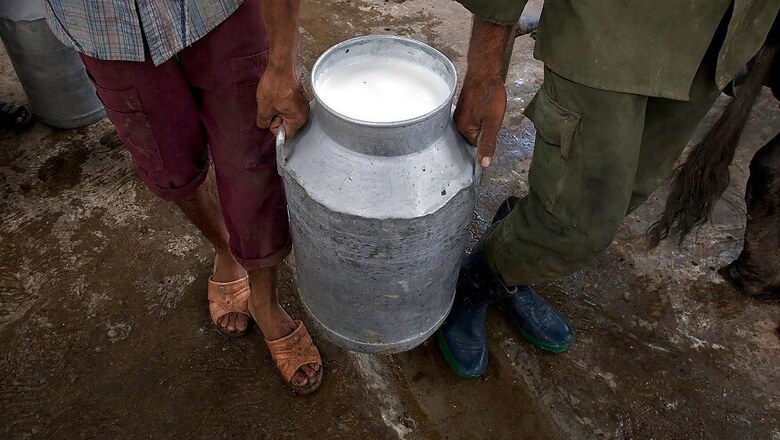
views
New Delhi: For much of this winter, onions were causing copious tears as prices reached unprecedented levels.
Now, as increased supplies have cooled the onion fire, prices of milk and pulses are on the boil and have continued to fuel inflation. Such fears over non-vegetable food inflation continue to dictate India’s monetary policy, with the Reserve Bank of India (RBI) holding lending rates in its bi-monthly announcement on Thursday morning.
Besides rising prices of milk and pulses, the hardening of global prices of crude are also fuelling continued concerns on inflation.
In fact, the RBI has raised its consumer price index (CPI) inflation projection to 6.5% for the current quarter (January-March 2020). The RBI’s decision to hold rates means EMIs for housing and other loans will not become any easier on the ‘aam aadmi’ just yet.
The repo rate – rate at which the RBI lends to banks – remains at 5.15% after this morning’s announcement though the monetary policy committee maintained its “accommodative” stance.
The RBI has, throughout this fiscal, done the heavy lifting as far as boosting economic activity is concerned, by cutting rates in each of its policy meetings, but the last two.
In December, the bank held rates for the first time this fiscal, citing rising inflation. It was also decided at the meeting that lending rates would not lowered further, keeping the inflation bugbear in mind.
In the policy statement, the RBI noted that in December 2019, CPI inflation was projected at 5.1-4.7% for the second half of 2019-20 and 4.0-3.8% for first half of 2020-21, with risks broadly balanced.
“The actual inflation outcome for the second quarter at 5.8% overshot projections by 70 basis points (0.7%), primarily due to the intensification of the onion price shock in December 2019 on account of unseasonal rains in October-November,” it said.
The central bank further said that inflation has surged above the upper tolerance band around the target in December, primarily on the back of the unusual spike in onion prices.
“Over the coming weeks and months, onion prices are likely to ebb as supply conditions improve. The salutary effects on headline inflation are, however, likely to be tempered by hardening of prices of other food items, notably those of pulses and proteins.”
The RBI said that going forward, the trajectory of inflation, excluding food and fuel, needs to be carefully monitored as the pass-through of remaining revisions in mobile phone charges, the increase in prices of drugs and pharmaceuticals and the impact of new emission norms play out and feeds into inflation formation.
“The MPC anticipates that the combination of these factors may keep headline inflation elevated in the short-run, at least through H1:2020-21. Overall, the inflation outlook remains highly uncertain. Accordingly, the monetary policy committee will remain vigilant about the potential generalisation of inflationary pressures as several of the underlying factors cited earlier appear to be operating in concert.”
Meanwhile, on the GDP front, the RBI has projected a growth rate of 6% for 2020-21. This means the bank is being cautious in its projections since this year’s Economic Survey placed GDP growth in 2020-21 between 6-6.5%.
However, following are some green shoots in India’s otherwise slothful economic activity are visible, according to the central bank’s assessment:
- Industrial activity, measured by the index of industrial production (IIP), improved in November after contracting in the previous three months. The output of core industries returned to positive territory in December after four months of contraction, buoyed by five out of eight of its constituents – coal; refinery products; fertilisers; steel; and cement.
- Capacity utilisation (CU) in the manufacturing sector fell to 69.1% in the second quarters from 73.6% in first quarter; seasonally adjusted CU also eased to 70.3% from 73.4%.
The RBI’s industrial outlook survey points to weak demand conditions facing the manufacturing sector in the third quarter. But the bank’s business expectations index suggests an improvement in the fourth quarter.
This is corroborated by the manufacturing purchasing managers’ index (PMI) for January 2020 which picked up sharply to 55.3 from 51.2 in November 2019 on the back of increased output and new orders.
- Several high frequency indicators of services have turned upwards in the recent period, pointing to a modest revival in momentum, although the outlook is still muted.
- Among indicators of rural demand, while tractor sales grew by 2.4% in December after ten months of a decline, motorcycle sales continued to contract.
Domestic air passenger traffic – an indicator of urban demand – posted double-digit growth in November, followed by a modest growth in December. Growth in three-wheeler sales and railway freight traffic has accelerated, while port traffic turned around in December.
On the other hand, passenger vehicle sales continued to contract. The PMI services index improved to 55.5 in January 2020 from 52.7 in November 2019, boosted by a rise in new business and output.




















Comments
0 comment